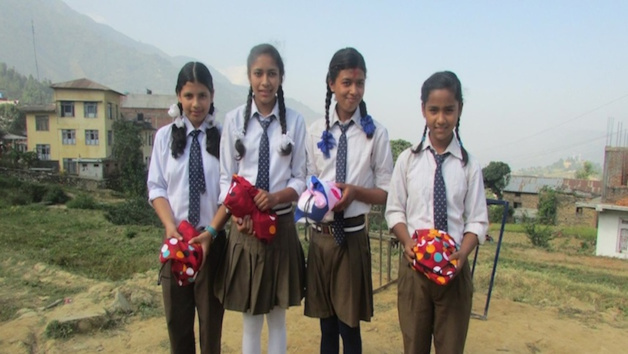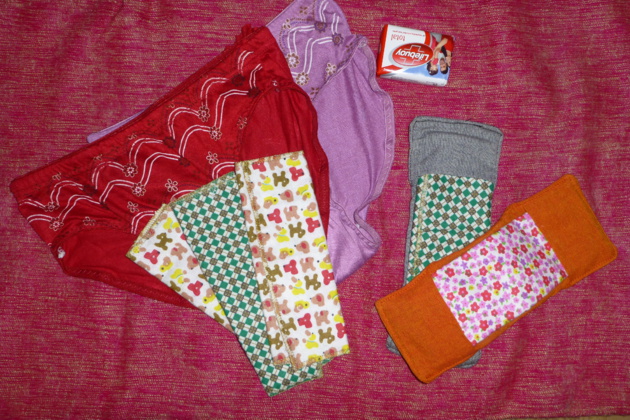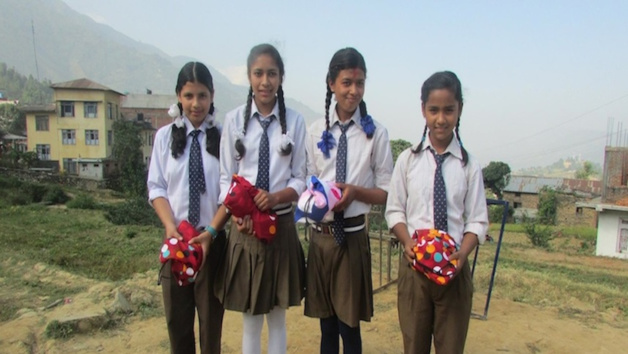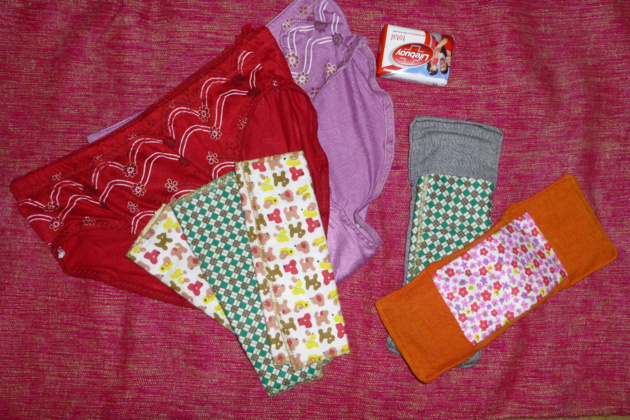
“We take a bag. In it, we put soap, underwear, a small towel to dry oneself. To finish, we had four reusable towels and two sanitary pads.” Carol and I are seated, right in the middle of a pile of bags, soaps, small squares of colourful tissues, and underwear. In a few hours, this heap will have given way to twenty hygienic kits. These bags will be distributed to the young girls of the village school, the Superb Catalyst Academy. It was Carol, an Australian volunteer, who had the idea. Taking centre stage are the sanitary pads, or “sanitary towels”. Those which Carol and I busy ourselves with organising are very different to those found sold in France.
They are reusable. Of course, even if this object is a bit more cumbersome than those which we are used to, it is in truth very aesthetic and easy to use. Small patterned towels are slipped through a pocket in coloured tissue, before all are attached to the underwear with the use of Velcro. The towels lift off easily when they are dirty, and then all that is needed is to put another in its place. In terms of hygiene, it is considerable progress. In Nepal, where women make do with what they have and often use old dirty rags or sawdust, the sanitary pad is like a gift fallen from heaven.
An asset for hygiene and the environment

The idea of these towels was born thanks to Arunachalam Muruganantham, whose lecture you can watch on the site TEDTalk. In India, he faced the same disastrous conditions of personal hygiene as those that are to be found in Nepal. If the solution he proposes is a little different, the problem is the same. It is first of all a question of cost. For a Nepalese budget, disposable sanitary towels are far too expensive and only wealthy families and tourists can afford them. The other women remain left to their own devices.
Their room for manoeuvre is limited, as this omnipresent problem is yet the object of a taboo. Due to a lack of education and stubborn misogynist tendencies, Nepalese women are ashamed and hide themselves. In certain remote villages, women do not have the right to touch food when they are menstruating, and are isolated from the rest of society as they are considered impure. Distributing these towels is crucial not only to provide an immediate solution to menstrual discomfort, but also a new hope of integration for women.
The sanitary pads’ hook and loop structure is made in Katmandou by women from the Local Women’s Handicraft, a shop that sells quality products made from Nepalese material by women in a difficult situation. The reusable sanitary pads that we slide in are made of a waterproof fabric that Carol brings from Australia since she can’t find it in Nepal. Additionally to the support it provides to the local production, those pads are more ecological. As the waste treatment is nearly nonexistent and that rubbishes cover the streets of Nepali, this invention offers a sustainable solution at the environmental level.
that sells quality products made from Nepalese material by women in a difficult situation. The reusable sanitary pads that we slide in are made of a waterproof fabric that Carol brings from Australia since she can’t find it in Nepal. Additionally to the support it provides to the local production, those pads are more ecological. As the waste treatment is nearly nonexistent and that rubbishes cover the streets of Nepali, this invention offers a sustainable solution at the environmental level.
Usage remains hesitant.
A few days after distributing these bags to the young girls and their mothers, I made a curious discovery. At the village school, a young girl of about two years of age had a bib which seemed strangely familiar to me: her mother had attached one of the reusable towels to the girl’s uniform, with the aid of a pin. There was no doubt that she had not been given the instructions regarding the towels and had no idea how to use them. Perhaps she was also perfectly aware that the towels were not meant to be used as handkerchiefs, but had decided that she wanted to make use of them in this way. This anecdote is representative of a phenomenon that I observed on a larger scale. Humanitarian aid is often founded on contribution, and is always based on good intentions. However, if only due to not explaining clearly enough to the local populations as to what these contributions are useful for, this same contribution could turn out to be useless, if not counter-productive. That brings me to my second point, which is even more important. If the woman in question feels she has greater need of a handkerchief for her daughter than a sanitary towel, nobody can stop her from doing as she sees fit with the object she has been given. Only the recipient can know the true value of what they are being given.





























